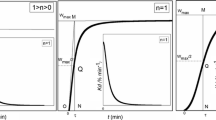Abstract
The effects of physical aging on the water permeation of cellulose acetate and ethylcellulose, the mechanical properties of ethylcellulose, and the dissolution property of hydroxypropyl methylcellulose phthalate were investigated. The water permeabilities of cellulose acetate and ethylcellulose and the dissolution rate of hydroxypropyl methylcellulose phthalate were found to decrease with physical aging time after being quenched from above the glass transition temperatures to sub-T g temperatures. The gradual approach toward thermodynamic equilibrium during physical aging decreases the free volume of the polymers. This decrease in free volume is accompanied by a decrease in the transport mobility, with concomitant changes in those properties of the polymer that depend on it. The effects of long-term aging on the dissolution rate and water permeabilities of these polymers can be estimated from a linear double-logarithmic relationship between the mobility properties and physical aging time. The existence of the linear double-logarithmic relationship can be derived from the Williams–Landel–Ferry (1) equation, the Doolittle (2) equation, Struik's (3) model, and Fujita's (4) relationship between diffusion and free volume.
Similar content being viewed by others
REFERENCES
M. L. Williams, R. F. Landel, and J. D. Ferry. The temperature dependence of relaxation mechanisms in amorphous polymers and other glass-forming liquids. J. Am. Chem. Soc. 77:3701 (1955).
A. K. Doolittle. Studies in Newtonian flow. II. The dependence of the viscosity of liquids on free-space. J. Appl. Phys. 22:1471–1475 (1951).
L. C. E. Struik. Physical Aging in Amorphous Polymers and Other Materials, Elsevier, Amsterdam, 1978.
H. Fujita. Diffusion in polymer-diluent systems. Fortscher. Hochpolym.-Forsch. Bd. 3, S. 1–47 (1961).
N. G. McCrum, C. P. Buckley, and C. B. Bucknall. Principles of Polymer Engineering, Oxford University Press, New York, 1988.
R. Simha, J. G. Curro, and R. E. Robertson. Molecular dynamics of physical aging in the glassy state. Polym. Eng. Sci. 24:1071–1078 (1984).
R. E. Robertson. Effect of free-volume fluctuations on polymer relaxation in the glassy state. J. Polym. Sci. Polym. Symp. 63:173–183 (1978).
J. G. Curro, R. R. Lagasse, and R. Simha. Use of a theoretical equation of state to interpret time-dependent free volume in polymer glasses. J. Appl. Phys. 52:5892–5897 (1981).
R. E. Robertson, R. Simha, and J. G. Curro. Free volume and the kinetics of aging of polymer glasses. Macromolecules 17:911–919 (1984).
J. G. Wagner, G. W. Ryan, E. Kubiak, and S. Longs. Enteric coating. V. pH dependence and stability. J. Am. Pharm. Assoc. (Sc. Ed.) 49:133–139 (1960).
J. P. Delporte. Effects of ageing on physico-chemical properties of free cellulose acetate phthalate films. Pharm. Ind. 41(10):984–990 (1979).
C. M. Sinko, A. F. Yee, and G. L. Amidon. The effects of physical aging on the dissolution rate of anionic polyelectrolytes. Pharm. Res. 7:648–653 (1990).
C. K. Chai and N. G. McCrum. Mechanism of physical aging in crystalline polymers. Polymer 21:706–712 (1980).
A. J. Kovacs, R. A. Stratton, and J. D. Ferry. Dynamic mechanical properties of polyvinyl acetate in shear in the glass transition temperature range. J. Phys. Chem. 67:152 (1963).
H. H. Meyer, P.-M. F. Mangin, and J. D. Ferry. Dynamic mechanical properties of poly(n-butyl methacrylate) near its glass transition temperature. J. Polym. Sci. A3:1785–1792 (1965).
R. M. Barrer and R. R. Fergusson. Diffusion of benzene in rubber and polythene. Trans. Faraday Soc. 54:989 (1958).
P. I. Lee and N. A. Peppas. Prediction of polymer dissolution in swellable controlled-release system. J. Control. Rel. 6:207–215 (1987).
R. S. Harland, A. Gazzaniga, M. E. Sangalli, P. Colombo, and N. A. Peppas. Drug/polymer matrix swelling and dissolution. Pharm. Res. 5:488–494 (1988).
Author information
Authors and Affiliations
Rights and permissions
About this article
Cite this article
Guo, JH., Robertson, R.E. & Amidon, G.L. Influence of Physical Aging on Mechanical Properties of Polymer Free Films: The Prediction of Long-Term Aging Effects on the Water Permeability and Dissolution Rate of Polymer Film-Coated Tablets. Pharm Res 8, 1500–1504 (1991). https://doi.org/10.1023/A:1015890232106
Issue Date:
DOI: https://doi.org/10.1023/A:1015890232106




